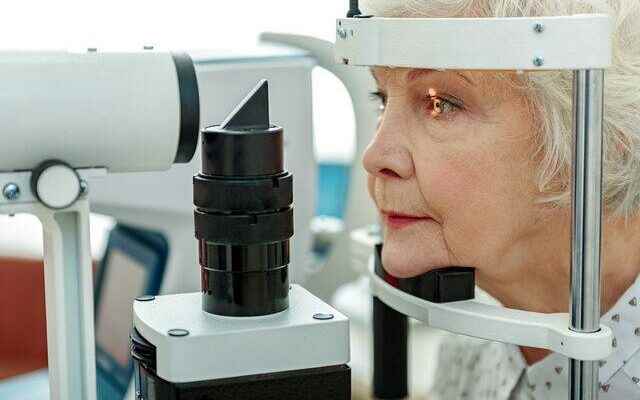In our country, only 1 out of 4 patients can be diagnosed. The reason for this is that glaucoma does not show any symptoms until permanent vision loss develops, so a physician is not consulted and routine examinations are neglected. Although it is usually seen in people over the age of 40, glaucoma, which can affect all age groups from the neonatal period, develops in two types, mainly open-angle and closed-angle.
THE SECRET DANGER IN THE EYES: GLAUCOMA
Acıbadem Ataşehir Hospital Ophthalmology Specialist Assoc. Dr. Muhsin Eraslan pointed out that open-angle glaucoma, which is the most common type of glaucoma, mostly progresses insidiously until a significant damage develops in the visual field. Unfortunately, the lost visual field and nerve cells cannot be restored. For this reason, it is very important for everyone to have an eye examination once a year for early diagnosis, even if they have no complaints. says.

THESE FACTORS INCREASES THE RISK
No cause can be identified in a very high rate of 90 percent of patients diagnosed with glaucoma. It is known that the risk of glaucoma increases 7-10 times in people with a family history of eye pressure. In addition, factors such as being over the age of 40, cortisone use due to any disease and traumas to the eye, which disrupt the anatomical structure of the eye, intraocular stenosis, narrowing of the flow paths in the eye due to cataracts, eye surgeries and increased blood pressure increase the risk of glaucoma.

DOESN’T SYMPTOM UNTIL THE LAST STAGE
Open-angle glaucoma does not show any symptoms until the last stage in a very high rate of 90 percent of patients. The narrowing of the visual field is the most typical symptom. However, since the visual field gradually narrows from the periphery to the center, it is only noticed by the patient in the late period. Eye pain, redness, blurred vision and sensitivity to light are among the most important findings in closed-angle glaucoma, which is more symptomatic. Ophthalmology Specialist Assoc. Dr. Muhsin Eraslan points out that although these symptoms are not seen in the early period, it is of great importance to consult an ophthalmologist without delay in order to prevent further progression of vision loss.

WHEN THE BALANCE OF THE INTRAOCULAR LIQUID IS IMPOSSIBLE…
Glaucoma develops as a result of the deterioration of the balance of the aqueous fluid produced in the eye and leaving the eye through small canals. Our eye contains the aqueous fluid that nourishes the eye structures and is routinely produced at 0.2 microliters per minute. This fluid is thrown out of the eye simultaneously under normal conditions. In glaucoma, obstruction occurs in the outflow tract of intraocular fluid due to congenital or subsequent causes. Therefore, the volume difference develops in the liquid produced and the liquid expelled. This picture results in an increase in the volume of fluid in the eye, resulting in an increase in the pressure inside the eye. Increased pressure in the eyes can also cause irreversible damage to the optic nerves.
TARGET EYE TENSION IS VERY IMPORTANT
The diagnosis of glaucoma is made with a detailed eye examination. After checking the visual acuity and the anatomical condition of the eye during the examination, the eye pressure is measured with a tonometer device. Then, with the OCT test, it is determined whether the nerve structure in the eye has been lost or not. If glaucoma is diagnosed, it is classified as early-middle-advanced stage and the target eye pressure is determined. Ophthalmology Specialist Assoc. Dr. Muhsin Eraslan, stating that it is extremely important to establish a separate target eye pressure for each patient in obtaining effective results from the treatment, said, “Because routinely setting the same target number for each patient may lead to worsening in glaucoma findings. So, for example, we set the target blood pressure as 18 mmHg for an early stage patient, while targeting below 12 mmHg for an advanced stage glaucoma.” says.
EYE EXAMINATION IS REQUIRED EVERY YEAR
It is not possible to reverse the damage to the optic nerve in glaucoma. Therefore, the only way to prevent permanent vision loss due to glaucoma is early diagnosis of the disease! Ophthalmology Specialist Assoc. Dr. Muhsin Eraslan, drawing attention to the fact that routine eye examinations should never be interrupted from the newborn period for early diagnosis, explains this process as follows: “Glaucoma can be seen not only in adults but also in children. Therefore, routine eye examination should be done at the age of 1.5 to 3 years, as well as at the 1st and 6th months after birth. From the age of 3 until adulthood, examinations should be continued every year. Especially in people over the age of 40, testing for elevated intraocular pressure and visual field defects caused by glaucoma also provides a great advantage in terms of early diagnosis.”
DAMAGE PROGRESS CAN BE PREVENTED
Although glaucoma treatment cannot provide a full recovery, the damage to the optic nerve can be stopped, so the current condition of the eye can be preserved. The aim of the treatment is to keep the intraocular pressure below a certain level. Ophthalmology Specialist Assoc. Dr. Muhsin Eraslan stated that the intraocular drops applied in the first stage are effective in most of the patients, and said, “However, in some patients, sufficient reduction in intraocular pressure cannot be achieved with drop treatment and visual field loss increases. In such cases, laser intervention is the option, and in cases where this method is not effective, surgical methods are used.” says.
